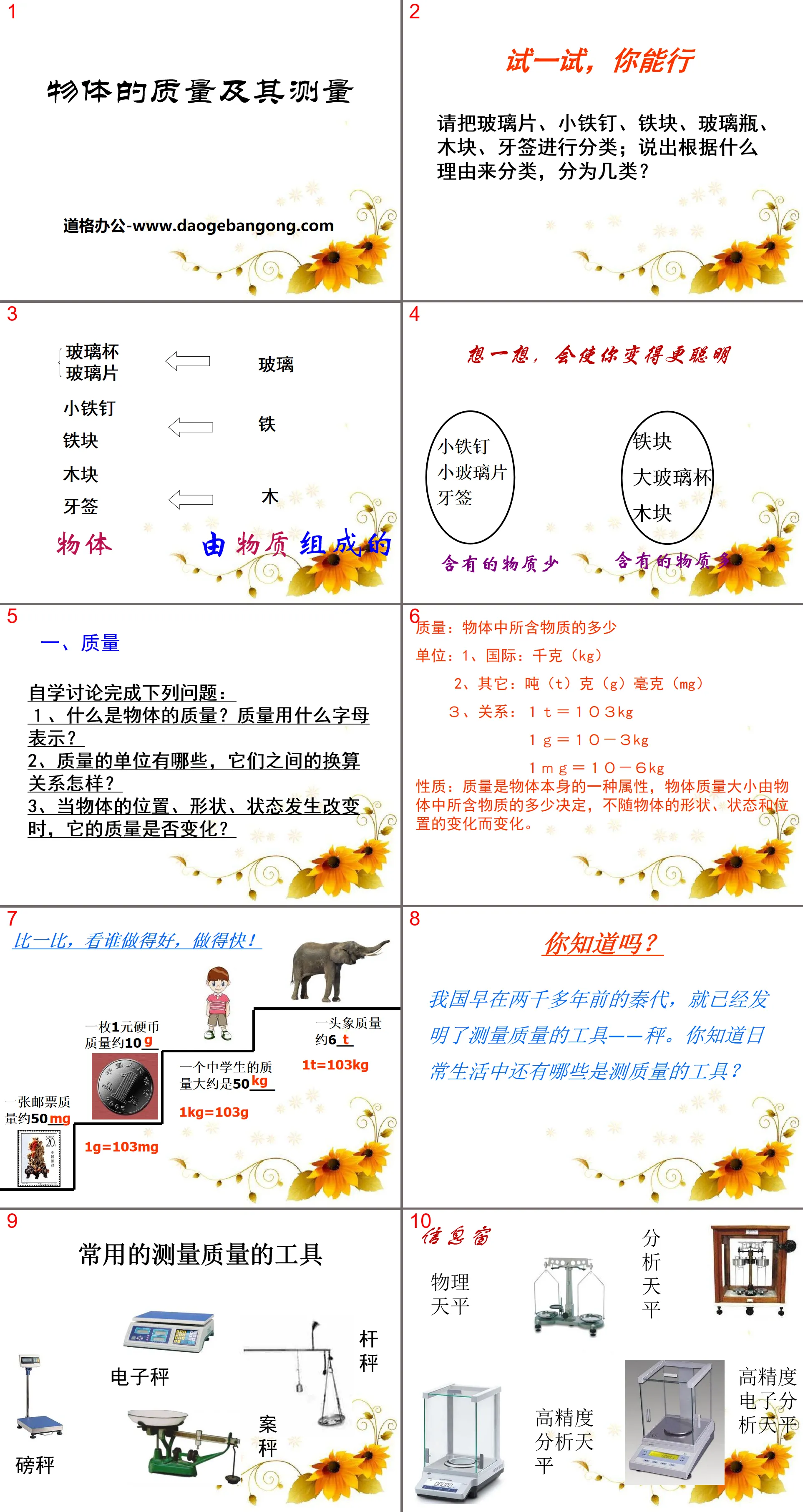People's Education Edition Physics for Grade 8, Volume 2
People's Education Edition Physics for Grade 8, Volume 1
People's Education Edition Ninth Grade Physics Complete Book
Shanghai Science Edition Ninth Grade Physics
Shanghai Science Edition 8th Grade Physics
Lu Jiao Edition Ninth Grade Physics Volume 2
Beijing Normal University eighth grade physics volume one
Beijing Normal University Ninth Grade Physics Volume 1
Lu Ke Edition High School Physics Compulsory Course One
Lu Jiao Edition Ninth Grade Physics Volume 1
Guangdong and Shanghai Edition Ninth Grade Physics Volume 1
People's Education Press High School Physics Compulsory Course II
Beijing Normal University Ninth Grade Physics Volume 2
Lu Jiao Edition Eighth Grade Physics Volume 2
Lu Jiao edition eighth grade physics volume 1
Guangdong and Shanghai Edition Ninth Grade Physics Volume 2

| Category | Format | Size |
|---|---|---|
| Beijing Normal University eighth grade physics volume one | pptx | 6 MB |
Description
"The Mass of Objects and Its Measurement" Scale, Mass and Density of the Material World PPT Courseware 2
Give it a try, you can do it
Please classify the glass pieces, small iron nails, iron blocks, glass bottles, wooden blocks, and toothpicks; tell us the reasons for classifying them, and how many categories they are divided into?
Think about it and it will make you smarter
small iron nail
small piece of glass
toothpick
Contains less substances
iron block
big glass
block
Contains many substances
1. Quality
Self-study discussion to complete the following questions:
1. What is the mass of an object? What letters represent quality?
2. What are the units of mass and what is the conversion relationship between them?
3. When the position, shape, and state of an object change, does its mass change?
Mass: How much matter an object contains
Unit: 1. International: kilogram (Kg)
2. Others: tons (t) grams (g) milligrams (mg)
3. Relationship: 1t=103Kg
1g=10-3Kg
1mg=10-6Kg
Properties: Mass is an attribute of the object itself. The mass of an object is determined by the amount of material contained in the object, and does not change with changes in the shape, state and position of the object.
Measurement of quality
As a group, discuss the following questions:
1. What instruments are used to measure quality in the laboratory? What are the main structures of a pallet balance?
2. In order to maintain the accuracy of the balance, what requirements should we meet?
3. How to use a pallet balance to weigh the mass of an object?
2. Measurement of quality
1. A common tool for measuring mass in the laboratory is a balance, which is divided into tray balance and student balance.
2. When using the balance, please pay attention to:
(1). Each balance has its own weighing capacity, which is the maximum mass it can weigh. The mass of the object being measured cannot exceed the weighing capacity.
(2) When adding or subtracting weights to the right plate, use tweezers. Do not touch the weights with your hands, and do not get the weights wet or dirty.
(3) Wet objects and chemicals cannot be placed directly into the balance tray.
Use a balance to measure the mass of aluminum blocks and learn how to use the balance
1. Work in groups and conduct experiments
2. Communicate between groups and summarize how to use the scale
Note when experimenting:
1. How to place the balance?
2. How to adjust the balance before and during measurement? How to tell if a scale is balanced?
3. When measuring, which pan should the object and the weight be placed in? In what order do you add weights?
4. How to read the travel code? How to calculate the mass of an object?
Basic steps for using a pallet balance:
(1) Leveling: Place the balance on a horizontal platform, and use tweezers to move the scale to the zero mark on the left end of the ruler.
(2) Adjust the balance: adjust the balance nut on the right end of the beam (if the pointer points to the left side of the indexing plate, adjust the balance nut to the right; otherwise, adjust the balance nut to the left) so that the pointer points to the center line of the indexing plate. , the beam is balanced at this time.
(3) Weighing: Place the object to be measured on the left pan. After estimating the mass of the object to be measured, use tweezers to add or subtract appropriate weights to the right pan in order from large to small, and move the ruler upstream appropriately. yard position until the crossbar returns to equilibrium.
(4) Reading: When the balance is balanced, the mass of the object being measured on the left disk is equal to the mass of all the weights on the right disk plus the scale value corresponding to the wandering code.
(5) Arrangement: After the measurement, use tweezers to clamp the weight back into the weight box, and organize the equipment to restore it to its original condition.
Gains from this lesson
1. Know the preliminary concept of quality and its units;
2. Know that mass is a property of the object itself, and it does not change with changes in the shape, state, and position of the object;
3. Master the use of pallet balance through practical operations;
4. Learn to use a balance to measure the mass of solids and liquids
1. Complete the following unit conversions.
(1)3×10-5t=______kg=_____mg.
(2)4.2×106g=_____kg=_____t.
2. The object with the closest mass to 50g may be ( )
A. A grain of sand B. An egg C. A pen D. A hen
3. When adjusting the pallet balance, first place the balance on _____; then move the scale to _____, and then adjust ____ so that the pointer points to _____.
4. When using a balance, the weights should be held with _____ instead of hands. The mass of the object being measured cannot be greater than ____.
5. When using a balance to measure the mass of an object, moving the cursor on the scale is equivalent to moving _____ into the balance plate.
6. The mass of an ordinary middle school student is about ____kg. When it loses weight in space, its mass is ____kg.
7. When 3kg of water freezes into ice, the mass of the ice is ___kg. When a 2kg can is taken into space, its mass is ____kg.
power enhanced
When using a balance to measure the mass of an object, the weights added to the right pan are: 50g, 2g, 5g, and one weight each corresponds to the scale as shown in the figure.
1. How to measure the mass of a stamp using a balance?
2. How to measure the mass of liquid using a balance?
Keywords: teaching courseware on scale, mass and density of the material world, teaching courseware on the mass and measurement of objects, Beijing Normal University edition eighth grade physics PPT courseware download, eighth grade physics slide courseware download, scale, mass and density of the material world PPT Courseware download, mass of objects and their measurement PPT courseware download, .PPT format;
For more information about the "Scale, Mass and Density of the Material World, the Mass of Objects and Their Measurement" PPT courseware, please click the Scale, Mass and Density of the Material World ppt, the Mass of Objects and its Measurement ppt tag.
"The Mass of Objects and Its Measurement" Scale, Mass and Density of the Material World PPT Courseware 5:
"The Mass of Objects and Their Measurement" Scale, Mass and Density of the Material World PPT Courseware 5 Review Objectives: 1. Be able to use the scale correctly and measure the length and read it correctly 2. Understand that mass is an attribute of matter and does not depend on the matter. Changes in shape, state, position...
"The Mass of Objects and Its Measurement" Scale, Mass and Density of the Material World PPT Courseware 4:
"The Mass of Objects and Their Measurement" Scale, Mass and Density of the Material World PPT Courseware 4 Think about it: 1. What are the similarities and differences between a nail and a pin? 2. What are the similarities and differences between a glass of water and a bucket of water? 3. A reinforced concrete structure..
"The Mass of Objects and Its Measurement" Scale, Mass and Density of the Material World PPT Courseware 3:
"The Mass of Objects and Their Measurement" Scale, Mass and Density of the Material World PPT Courseware 3 Question: Compared with an iron nail and an iron door, what are the similarities between the two, and what are the differences between them? 1. The mass of an object: 1. Definition: The amount of matter contained in an object..
File Info
Update Time: 2024-11-15
This template belongs to Physics courseware Beijing Normal University eighth grade physics volume one industry PPT template
"The Mass of Objects and Its Measurement" Scale, Mass and Density of the Material World PPT Courseware 2 Simple campus recruitment activity planning plan summary enterprise and institution recruitment publicity lecture PPT template is a general PPT template for business post competition provided by the manuscript PPT, simple campus recruitment activity planning plan summary enterprise and institution recruitment promotion Lecture PPT template, you can edit and modify the text and pictures in the source file by downloading the source file. If you want more exquisite business PPT templates, you can come to grid resource. Doug resource PPT, massive PPT template slide material download, we only make high-quality PPT templates!
Tips: If you open the template and feel that it is not suitable for all your needs, you can search for related content "The Mass of Objects and Its Measurement" Scale, Mass and Density of the Material World PPT Courseware 2 is enough.
How to use the Windows system template
Directly decompress the file and use it with office or wps
How to use the Mac system template
Directly decompress the file and use it Office or wps can be used
Related reading
For more detailed PPT-related tutorials and font tutorials, you can view: Click to see
How to create a high-quality technological sense PPT? 4 ways to share the bottom of the box
Notice
Do not download in WeChat, Zhihu, QQ, built-in browsers, please use mobile browsers to download! If you are a mobile phone user, please download it on your computer!
1. The manuscript PPT is only for study and reference, please delete it 24 hours after downloading.
2. If the resource involves your legitimate rights and interests, delete it immediately.
3. Contact information: service@daogebangong.com
"The Mass of Objects and Its Measurement" Scale, Mass and Density of the Material World PPT Courseware 2, due to usage restrictions, it is only for personal study and reference use. For commercial use, please go to the relevant official website for authorization.
(Personal non-commercial use refers to the use of this font to complete the display of personal works, including but not limited to the design of personal papers, resumes, etc.)
Preview










